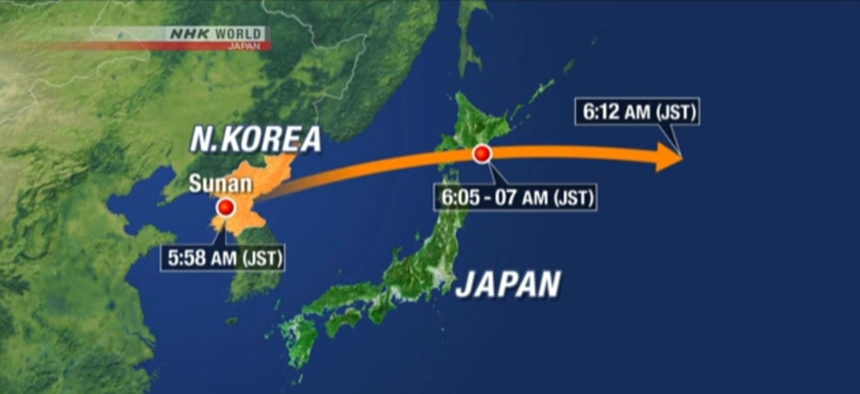
Screengrab from a report by Japanese news NHK on August 28, 2017.
What Does It Mean for North Korea to Fly a Missile Over Japan?
This latest strike may be Pyongyang’s most provocative test this year.
North Korea staged its 18th, and perhaps most provocative, missile test of the year Monday night Eastern Time over Japan’s northernmost main island, following a month in which North Korean and American leaders have traded threats.
The missile, whose launch was confirmed by the Pentagon and South Korea’s joint chiefs of staff, flew 1,678 miles over the northern Japanese island of Hokkaido for approximately 14 minutes before breaking into three pieces and crashing into the Pacific Ocean. The Japanese military did not attempt to shoot down the missile, though it did alert those within its range to take necessary precautions. Japanese Prime Minister Shinzo Abe, speaking to reporters early Tuesday morning local time, said the government is doing its utmost to protect Japanese citizens from what he called an “unprecedented, grave, and serious threat.”
The flight path was alarming, though not unprecedented. As The Diplomat’s Ankit Panda reported earlier this month, a North Korean missile (nominally a satellite launch vehicle) flew over Japan in 1998. Per Panda, “That test generated immense controversy and precipitated its self-imposed testing moratorium. While the moratorium spectacularly collapsed in 2006, North Korea has never since overflown Japan with any missiles with the exception of its failed 2009 launch of the Taepodong-2 SLV, which landed in the Pacific.” More recently, North Korean missiles have landed in Japanese waters, prompting condemnation from Japan but little change in posture, Panda notes.
Still, North Korea’s decision to launch a missile directly over Japan—for the first time in eight years—is significant. “If North Korea is reckless enough to launch these over populated areas, and then the missile breaks up, what happens of course if it falls onto a populated area and causes casualties?” Michael Auslin, the Williams-Griffis Fellow in Contemporary Asia at the Hoover Institution, said. “At some point there could be an accident or a mistake, and you’re plunged into a crisis.”
Though Auslin said Japan could shoot down a missile if it were deemed a threat to its collective self-defense (including that of a key ally), he noted that such an action has not been taken before—in part because it’s not easy. “The risks of trying to intercept one of these missiles and failing is extremely high,” he said. “Unless you knew for certain that either because it was an intentional launch towards a population center or an accident, these decisions have to be made in an extremely short period of time. … Japan at least has the ability to attempt to act—whether it is actually prepared to do so is entirely different.”
Regardless, it was known before Monday that North Korea had the ability to fly missiles over or near Japan. In May, for instance, North Korea test-fired an intermediate-range ballistic missile that reached an altitude of 1,300 miles but landed within a few hundred miles of North Korea’s own coast—the idea being to demonstrate the missile’s possible range without directly threatening neighbors. Had it flown normally, according to experts who spoke to Reuters, that missile would have had a range of some 2,500 miles, putting Japan easily within range. In July, North Korea demonstrated a further technological advance when it tested missiles that experts believe could put the continental United States within range, with the estimated ability to fly some 6,500 miles.
As a result, the message of Monday’s test is less technical than political, said James Acton, the co-director of the nuclear policy program at the Carnegie Endowment for International Peace. “I think you have to look at this test more than anything else as a signal to the United States,” he said. Having warned North Korea in unusually bellicose terms not to threaten America earlier this month, President Donald Trump at a recent rally noted that he thought Kim Jong Un was beginning to respect the United States, given what seemed to be a pause in North Korea’s missile testing. That apparent pause ended last Friday as the United States and South Korea engaged in annual joint military exercises that the North has long viewed as a provocation. (North Korea has tested missiles during such exercises in the past.)
Friday’s test involved short-range missiles that flew about 155 miles before crashing into the sea. The missiles launched Monday flew much further. “I would interpret this as a political signal by the North Koreans that they are not cowed,” Acton said.
Still, he noted, the fact that the missile went nowhere near Guam—the American territory in the Pacific that Kim threatened to target in unusually specific terms earlier in August—might also signal that the North is calibrating its provocations to avoid outright confrontation with the United States. When a mid-August statement in North Korean state media spelled out the path a missile would travelto reach Guam, the trajectory specified traversed southwestern Japan—just about the opposite end of the country from the path taken by the missile launched on Monday.
Though as of this writing the White House had yet to formally comment on the strike, Auslin said both the U.S. and Japanese response will require more than a war of words. “We watched the development of this North Korean capability for decades,” Auslin said. “This is a different world now and sadly our political and military responses are lagging behind the threat.”